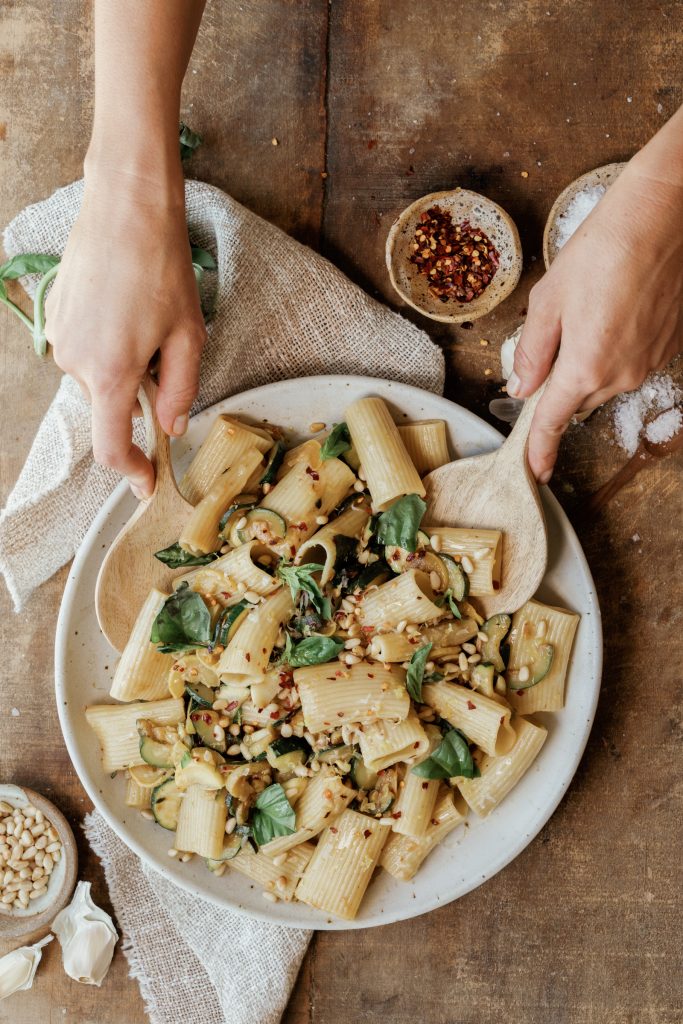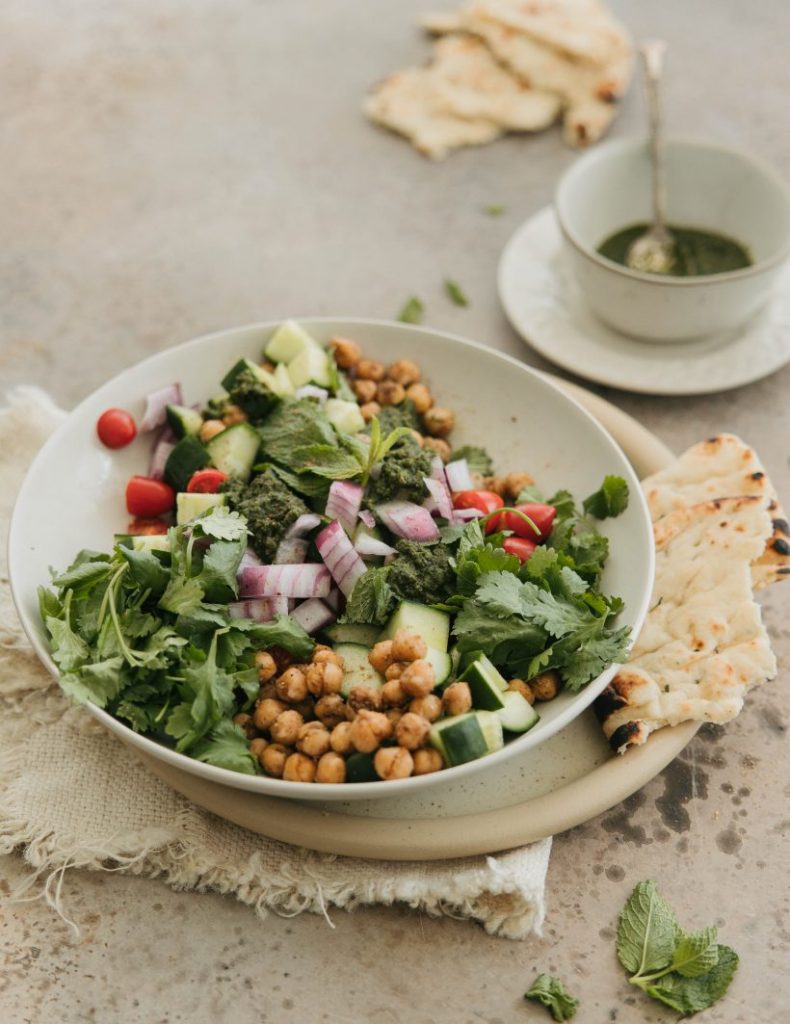
In the ever-evolving world of superfoods, there’s a humble contender worth the pantry space. With its impressive nutrients and versatility, say hello to lupini beans—the unsung heroes of legumes. Beyond their nutritional profile, lupini beans couldn’t be easier to incorporate. Whether you’re a fiber fanatic, a hormone-balancing queen, or home chef with a knack for creativity, add lupini beans to your grocery list. From snacking beans and salads—to pastas and hummus—there’s no shortage of ways to use lupini beans. Let’s revolutionize your meals with these nutrient-packed gems.
Featured image by Suruchi Avasthi.
In this article
What are lupini beans?
Lupini beans—also known as lupin beans—are a type of legume. They’re oval-shaped and come in various neutral colors. A close relative of peas, their history runs deep. For centuries, they’ve been a Middle Eastern dietary staple. But they’ve started filling more grocery aisles, thanks to their impressive nutritional profile. Lupini beans are renowned for their high protein content, making them an excellent source of plant-based protein! On top of that, lupini beans are rich in dietary fiber, low in fat, and are naturally gluten-free.
What do lupini beans taste like?
Lupini beans have a nutty flavor and slightly mealy texture. Because of this, they’re a versatile ingredient in a range of dishes and cuisines. That said, they need to be soaked properly and fully cooked. Otherwise, lupini beans are super bitter—due to their alkaloids. You can buy them whole or enjoy them ground, as a snacking bean, or even as a low-carb pasta. No matter your preference, this is a protein-packed and fiber-rich plant food to add to your repertoire.

Health Benefits of Lupini Beans
When prepared properly (more on this, below), lupini beans have an impressive nutritional composition. Here are a few key health benefits:
High in protein
Lupini beans are an excellent source of plant-based protein. In fact, one cup of lupini beans contains over 60 grams of protein! This is an ideal choice for vegetarians, vegans, and omnivores alike.
Rich in fiber
Like most beans and legumes, lupini beans are high in dietary fiber. This encourages digestive health, helps regulate blood sugar levels, and aids in both satiety and weight management. Speaking of digestive health, they’re known to promote regular bowel movements and prevent constipation.
Low in fat
Lupini beans are naturally low in fat—particularly, saturated fat. They’re a heart-healthy choice that can mitigate the risk of cardiovascular diseases. Furthermore, some studies suggest that lupini beans may help reduce cholesterol levels in the blood.
Naturally gluten-free
Whether you’re gluten sensitive or have celiac disease, lupini beans are naturally gluten-free.
Contain essential nutrients
Lupini beans are a good source of essential nutrients such as iron, magnesium, calcium, phosphorus, and potassium, which contribute to overall health and well-being. In particular, these minerals help maintain strong bones.
Support stable blood sugar
Thanks to their fiber and protein, lupini beans can help stabilize blood sugar levels. This is key for energy, hormone health, and minimizing long-term chronic conditions, like diabetes.
Reduce inflammation
These beans contain antioxidants, including flavonoids and polyphenols, which can help protect cells from oxidative stress and inflammation.

How to Properly Prepare Lupini Beans
If you’re cooking lupini beans the old-school way (raw beans to boiled goodness), you’ll need a bit of time. Read: 5-7 days. If that’s not in your wheelhouse, try lupini beans in the form of pre-packaged snacking bean or pasta. That said, if you’re down to make them from scratch, we promise it’s easy. Although the soaking process takes time, it’s necessary. The end result? A tender, slightly nutty-flavored bean that you can use in salads, soups, spreads, etc.
Ingredients:
- Dried lupini beans
- Water
- Salt (optional)
Instructions:
- Inspect and rinse. Examine dried lupini beans for any debris or stones. Discard any damaged beans. Rinse the beans under cold running water.
- Soak in cold water. Place the cleaned lupini beans in a large bowl or pot, and cover them with cold water. Use about 3 to 4 cups of water for every cup of dried lupini beans. The beans will expand as they soak—make sure there’s enough water to keep them fully submerged.
- Add salt. This is optional, but adding salt to the soaking water will help with the beans’ bitterness. Add 1-2 tablespoons of salt per cup of beans.
- Soak. Lupini beans require an extended soaking period, typically ranging from 5-7 days. During this time, change the water daily. The beans will gradually expand and absorb water.
- Test for bitterness. After 5-7 days, taste a lupini bean to check for bitterness. If the bitterness is still present, continue soaking and changing the water daily until it’s mostly gone. The time required may vary depending on the beans (and your preference).
- Boil and rinse. Once the lupini beans are no longer bitter, it’s time to cook them! Transfer the beans to a large pot, cover them with fresh water, and bring them to a boil. Boil the beans for about 15-20 minutes. This step also helps remove any remaining bitterness. Drain the boiled lupini beans and rinse them under cold water.
- Use as desired. Your soaked and cooked lupini beans are now ready to be used in various recipes.

7 Ways to Add Lupini Beans to Your Diet
Not sure how to incorporate lupini beans into your favorite meals? Fortunately, you can savor these beans in many forms.
Snacking beans
A convenient and nutritious snack, they’re typically sold brined or pickled. Just rinse them well to remove excess salt, and you’re ready to relish their nutty flavor. Add them to a charcuterie board or enjoy with sliced veggies and tzatziki.
Pasta
You can find lupini bean pasta in various shapes and sizes! Best of all, they can easily be swapped for regular noodles. Try our red pepper pasta or our vegan cauliflower mac and cheese.
Hummus
Did you know that lupini beans can be used as an alternative to chickpeas? Enter: hummus. The result is a creamy and flavorful lupini bean hummus that pairs perfectly with pita bread, veggies, or as a sandwich spread.
Salads
Add cooked lupini beans to any salad for an extra boost of protein and fiber. They’re a fantastic addition to green salads, grain bowls, or mixed with lentils for a hearty bean salad.
Soups
Toss lupini beans into soups and stews. They add a rich, creamy texture and a unique flavor. We love them best in this curry butternut squash soup.
Spreads
Along with hummus, make a lupini bean spread by blending the beans with olive oil, garlic, lemon juice, and salt. Serve as a dip or spread on sandwiches and crackers.
Veggie burgers
Make vegetarian or vegan lupini bean burgers! Simply mash cooked lupini beans with ingredients for our sweet potato falafel burgers.
The post This Superfood Is Known to Balance Blood Sugar and Boost Digestion—We’re Obsessed appeared first on Camille Styles.

0 Comments